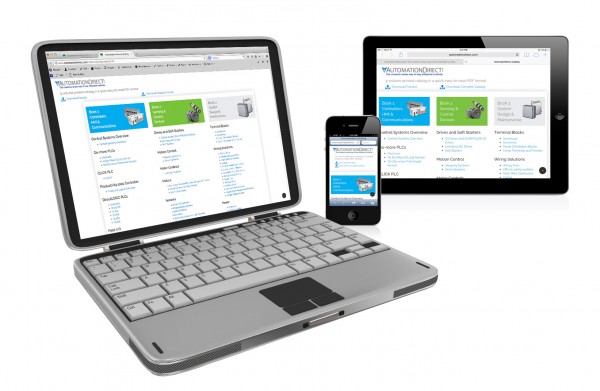Many existing industrial automation trends gathered strength and reached Top 10 status in 2014, and some new ones emerged and now merit inclusion on the list. All industry participants should be aware of these trends as they will affect many aspects of industrial automation going forward.
Top 10 Industrial Automation Trends
- Multi-Touch Technology
- Industrial Automation Mobile Apps
- Built in HTML5 Support
- BYOD
- Online Research and Purchasing
- Grid Computing and Virtualization
- Industrial Wireless
- Robot Revolution
- Rise of DC Power
1. Multi-Touch Technology
Like many trends, multi-touch started in the commercial world and migrated to industrial automation. The driving force for this trend is user demand for the speed, power and flexibility of multi-touch in their plant floor operator interface applications, summarized in this White Paper. After exposure to the advantages of multi-touch through smartphones and tablets, users will no longer accept the older, inferior single-touch technology. Suppliers are responding by incorporating multi-touch technology into their products. Newer versions of Windows have built-in multi-touch support, as do most modern touchscreens. Application software like AutomationDirect’s Point of View also has native multi-touch support, making it easy for users to design their applications to take full advantage of its capabilities.
2. Industrial Automation Mobile Apps
Smartphone and tablet users love their apps as it’s much faster to obtain information by touching a single button than by starting up a web browser, typing in a URL and navigating to the correct page. Developers have responded by making thousands of apps available for everything from finding the nearest happy hour to checking the latest sports score. In the world of industrial automation, apps are finding a home as the latest and greatest way to quickly access plant operating information from smartphones and tablets. Simply press an on-screen button, and a customized view of a manufacturing facility quickly appears on the screen, ready for instant access.
3. Built-in HTML5 Support
Although apps are great for users, they take much longer to develop than browser-based access. Most plants have a number of PC-based human machine interface (HMI) platforms, and most of these run off-the-shelf HMI software. Leading HMI software packages offer built-in HTML5 support, as does most every mobile device operating system. This mutual support for the HTML5 standard allows users to develop remote access screens conforming to the HTML5 standard, and then deploy these screens to almost any remote device. This write-once and deploy-many-times functionality saves time and simplifies browser-based remote access.
4. BYOD
Rare is the industrial automation professional who doesn’t own a smartphone, a tablet or both. Ownership and constant use brings familiarity, and the desire to use these personal devices for business purposes is increasingly supported by employers. For the end user, bringing your own device (BYOD) to work offers convenience, ease-of-use and built-in remote access. For their employers, BYOD is much cheaper than supplying a separate mobile device to each employee. There are some security concerns, but methods exist to deal with these, ensuring BYOD practices will continue to grow and prosper.

5. Online Research and Purchasing
Back in the day, industrial automation products were purchased from distributors who came to plants bearing donuts, product brochures and pricing information. As this Control Design survey shows, users now prefer to find products through the Internet, relying on search engines and other tools. In many cases, these same users are choosing to continue their online experience from research to purchase, mimicking the path many follow to buy products ranging from plane tickets to purses.
6. Online Learning
Just as growing numbers of people want to use the Internet to research and buy products, so it is with learning. The old paradigm of employment for life with a company that would provide lifelong training has gone by the wayside. In its place is the requirement for automation professionals to be responsible for their own professional development, and many are turning to the Internet as a source for this training. Vendors are responding by providing online content in the form of videos, e-books and other training materials, allowing users to select topics of interest and proceed with learning at times and places of their choosing.
7. Grid Computing & Virtualization
As the PC has become more powerful, its resources have become more underutilized in many commercial and industrial applications. Virtualization provides a means to efficiently utilize these resources by allowing multiple instances of operating systems to run on a single PC. One typical industrial automation application consolidates multiple server-level functions such as I/O, database and SCADA onto fewer PCs. This not only saves money as fewer PCs need to be purchased and maintained, it can also increase reliability by allowing near instantaneous switching from a failed to an operating PC. This Control magazine cover story provides details.
8. Industrial Wireless
This trend doesn’t have to do with wireless access by remote devices, but rather with wireless transmission of data from sensors to control systems. In a typical application, a sensor is installed in a remote location, maybe a tank farm, and transmits information via radio to a control system which may be located far away. In these and other similar applications, wireless communication is much cheaper to install and maintain as there are no wires to run and repair. Users are responding by increasing demand from near zero just a few years ago to over $500 million annually today, with double-digit growth rates projected for the foreseeable future.
9. Robot Revolution
Unlike many industrial automation trends, this one isn’t borrowed from the commercial world, but is instead migrating in the other direction, from industrial to commercial. Industrial robots used to be dumb devices designed to perform the same simple operation over and over, like picking a particular part from one specific location and placing it to the same spot. Nowadays, robots driven by software and vision systems can be programmed to perform a variety of tasks, which fits with today’s demand for flexible manufacturing.
10. Rise of DC Power
As this cover story shows, DC power is coming to the forefront, supplanting AC power in many instances. With high voltage transmission lines, DC provides advantages over AC in terms of efficiency and lower construction costs. At the user level, more end devices such as VFDs, computer hardware and other components use DC and have to provide conversion from AC internally. This is driving in-plant distribution systems to DC, as with server farms where most power consumption is DC.




